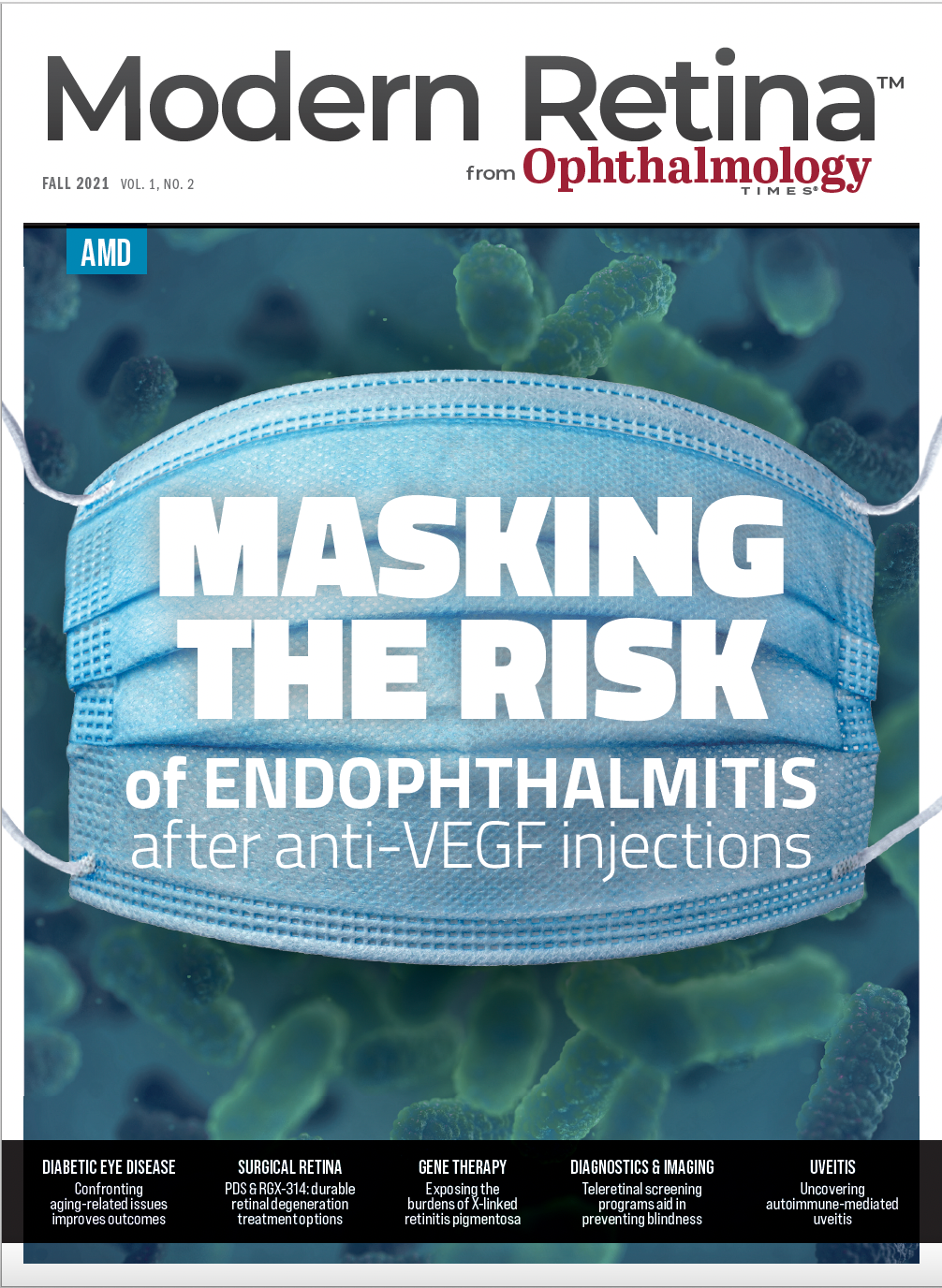Autoimmune disease and the eye: Current thinking and approaches to treatment
Underlying autoimmune disease alters uveitis therapy.

Autoimmune uveitis comprises a diverse group of diseases that can differ widely in clinical presentation and duration.1 Although a number of systemic autoimmune diseases can manifest as noninfectious uveitis (NIU)—for example, psoriasis, ankylosing spondylitis, multiple sclerosis, sarcoidosis, and ulcerative colitis—many cases of NIU are idiopathic. Indeed, in the US, most uveitis is of noninfectious or autoimmune origin, with a majority of those cases being idiopathic.2
Pathophysiology
The autoimmune mechanisms at work in the pathogenesis of uveitis are not completely understood; but it is known that the retina contains several potent autoantigens that are expressed in the thymus and secondary lymphoid tissue, where immunological tolerance is maintained. Regulatory T cells, which help maintain self-tolerance and control immune responses, are also present in the retina.3 In the context of an autoimmune disease, local dynamics of immune cell trafficking within the eye may be altered, and the resulting remodeling may put the eye at risk of nonspecific immune activation, precipitating clinical signs of inflammation.2
Uncovering autoimmune-mediated uveitis
Uveitis is categorized anatomically as anterior, intermediate, posterior, or panuveitis, with symptoms that generally correspond to the location of inflammation. When the inflammation predominantly affects the anterior segment, patients may experience pain, sensitivity to light, and redness; posterior-segment inflammation can result in floaters, flashes, blurry vision, and blind spots. Although patients with posterior uveitis may not experience pain, it is generally the most dangerous in terms of vision, as choroidal inflammation and its resultant scarring can affect the retina, optic nerve, and macula very quickly.4
In my experience, it is common for patients with NIU to present to the clinic without a previous diagnosis of systemic autoimmune disease; typically, they have experienced some worrisome vision loss or irritation that prompts their visit. They may, however, have other extraocular symptoms that they have been neglecting, such as joint pain (inflammatory joint pain is typified by exacerbation following a period of inactivity, such as wakening in the morning), nail pitting, or hair loss. Every patient new to our practice is asked to complete a 9-page questionnaire to help uncover ocular and systemic symptoms that he or she may not otherwise think to report.
In terms of ocular findings, diagnosis of anterior uveitis is relatively straightforward at the slit lamp; in cases of posterior-segment involvement, imaging tools such as optical coherence tomography (OCT), fluorescein and indocyanine green angiography, and fundus autofluorescence are essential adjuncts. For certain uveitic entities, visual field testing and electroretinogram can be helpful. In general, the diagnostic workup for a patient with NIU often requires time, consideration, and collaboration with other specialists. In addition to review of systems and ocular exam, we do bloodwork to rule out infection and help identify signs of systemic autoimmune activity (eg, HLA haplotyping, antinuclear antibodies, serum angiotensin-converting enzyme, lysozyme, to name a few). Even when a systemic workup is negative for infection or clearly defined autoimmune disease, patients can be comforted that we still have effective ways of managing uveitis that is presume autoimmune, noninfectious in nature.
Current treatment approaches
Our knowledge of ocular immunology has grown immensely over the past decade or two, revealing a complex web of interconnected pathways, signaling molecules, and surface markers involved in acute and chronic inflammation. In treating NIU and other autoimmune-mediated diseases, it is rarely as simple as blocking a single molecule and turning a single switch on or off. Still, in recent years, targeted biologic treatments for autoimmune disease have been approved, including some specifically for NIU.
Humira (adalimumab, AbbVie) is the first FDA-approved biologic therapy for noninfectious uveitis affecting the posterior segment. Most of the other systemic immunosuppressive therapies used to treat uveitis are off-label, including methotrexate, mycophenolate, azathioprine, and cyclosporine. Although these therapies have been used for many years, they do not have FDA approval for this indication and lack the support of randomized controlled trials.5
Through clinical experience, we know that these are excellent steroid-sparing medications. Although these therapies are well accepted today, in the past, many considered them as overly aggressive. Now, uveitis has become a “mainstream” subspeciality, and fellows at many respected academic and private institutions are well trained in the use of systemic therapies. In addition, physicians tend to refer patients to uveitis specialists much earlier than in the past, which lowers patients’ exposure to systemic steroids and their associated side effects.
In and out of specialists’ practices, however, steroids are still the mainstay of treatment because rapid control of inflammation is essential to preserving vision.
Local vs systemic therapy
For patients with NIU and a well-defined systemic autoimmune disease, systemic treatment is usually the best choice to control disease throughout the body. The question of systemic vs local treatment becomes more controversial if, after doing a head-to-toe work-up, the patient only manifests NIU and no other complaints. In such cases, it may make sense to treat systemically if the uveitis is bilateral, but perhaps locally if unilateral (but that ultimately depends on the specific diagnosis).
Local treatments for NIU are largely corticosteroids, though intraocular injection of agents such as sirolimus and methotrexate have been studied.6,7 Key considerations for local therapy include age and lens status, as well as individual or family history of glaucoma or steroid-induced ocular hypertension. A very young phakic patient, or one with numerous risk factors for glaucoma, may not be a good candidate for local corticosteroid therapy. On the other hand, patients who are pregnant or trying to conceive, or those who are immunocompromised, may be poor candidates for systemic therapy. Recently, even those with only a theoretical risk of compromised immunity (eg, due to age or recent recovery from cancer) are often reluctant to undergo systemic immunosuppression because they fear the SARS-CoV-2 infection.
Current approved options for local therapy include topical steroids, shorter-acting intra- and periocular steroids, such as triamcinolone acetonide, and sustained-release intravitreal implants, including Ozurdex (dexamethasone intravitreal implant 0.7 mg, AbbVie) and YUTIQ (fluocinolone acetonide intravitreal implant 0.18 mg, EyePoint Pharmaceuticals). Ozurdex is typically effective for about 3 to 4 months when used to treat uveitis, while YUTIQ releases a consistent low dose of fluocinolone for 36 months. The surgically implanted Retisert (fluocinolone acetonide intravitreal implant 0.59 mg, Bausch + Lomb), which also lasts about 36 months, is generally reserved for more severe presentations in which a higher dose of steroid is warranted.
I usually bring patients on systemic immunosuppressive therapy back for follow-up every 2 to 3 months to examine the eyes for signs of recurrent inflammation and perform blood testing to ensure the efficacy and safety of the therapy. For patients who receive local, sustained-release steroid treatment such as YUTIQ and Retisert, I also follow them every 3 months to monitor intraocular pressure.
In the pipeline
We can expect the future of immune-mediated uveitis to feature increasingly targeted and specific therapies, including more biologics and biologic response modifiers, both systemically and locally in the eye. In the immediate term, we can look forward to the suprachoroidal formulation of triamcinolone (Xipere, triamcinolone acetonide suprachoroidal injectable suspension, Bausch + Lomb)8, which may offer a more targeted impact on uveitic macular edema with fewer adverse events of IOP elevation and cataract development than other intra- and periocular steroids. We may also see the approval of intravitreal sirolimus (Santen), which would offer a local, non-steroid option.6
Case study: Preserving systemic immune function
I recently saw a 50-year-old man with metastatic melanoma, which was being successfully treated with immunotherapy. However, as a consequence of the immunotherapy, he had developed bilateral panuveitis, a side effect that has been reported with immune-checkpoint inhibitors.9 To avoid disrupting the patient’s systemic cancer care, we elected to treat the uveitis locally with YUTIQ following an incomplete response to topical steroid.
The patient experienced improvement in vision following YUTIQ injection and at about 18 months post-treatment, he remains 20/20 in both eyes. He did develop cataract, but is happy with his vision following surgery. Intraocular pressure (IOP) elevation, also secondary to YUTIQ, is well controlled on a single IOP-lowering drop.
In a 3-year, phase 3 clinical trial, patients who received YUTIQ experienced a statically significantly lower rate of uveitis recurrence compared to the sham/standard of care treatment arm (P<0.001).10 YUTIQ also resulted in greater resolution of macular edema and greater improvement in visual acuity.10,11 IOP-lowering medications were used at similar rates, but more patients in the sham/standard of care group received IOP-lowering surgeries.12
This case illustrates the important interaction between systemic immunity and ocular inflammation, and the value of long-term, local inflammation control.
--
Peter Y. Chang, MD
Dr. Chang is Co-President and Partner at Massachusetts Eye Research & Surgery Institution (MERSI) in Waltham, MA. He specializes in ocular inflammatory disease and vitreoretinal surgery.
--
References
Caspi RR. Understanding autoimmune uveitis through animal models. The Friedenwald Lecture. Invest Ophthalmol Vis Sci. 2011;52(3):1872-9.
Lee RW, Nicholson LB, Sen HN, et al. Autoimmune and autoinflammatory mechanisms in uveitis. Semin Immunopathol. 2014;36(5):581-594.
Forrester JV, Kuffova L, Dick AD. Autoimmunity, Autoinflammation, and Infection in Uveitis. Am J Ophthalmol. 2018;189:77-85.
Holland GN, Goldstein DA, Rosenbaum JT, Van Gelder RN. MD roundtable: the uveitis workup. EyeNet. 2017 March. https://www.aao.org/eyenet/article/md-roundtable-uveitis-workup Accessed September 14, 2021.
Knickelbein JE, Kim M, Argon E, Nussenblatt RB, Sen NH. Comparative efficacy of steroid-sparing therapies for non-infectious uveitis. Expert Rev Ophthalmol. 2017;12(4):313-319
Nguyen QD, Merrill PT, Sepah YJ, et al. Intravitreal sirolimus for the treatment of noninfectious uveitis: evolution through preclinical and clinical studies. Ophthalmology. 2018;125(12):1984-1993.
Taylor SR, Banker A, Schlaen A, et al. Intraocular methotrexate can induce extended remission in some patients in noninfectious uveitis. Retina. 2013;33(10):2149-54.
Yeh S, Khurana RN, Shah M, et al. PEACHTREE Study Investigators. Efficacy and safety of suprachoroidal CLS-TA for macular edema secondary to noninfectious uveitis: phase 3 randomized trial. Ophthalmology. 2020;127(7):948-955.
Shahzad O, Thompson N, Clare G, et al. Ocular adverse events associated with immune checkpoint inhibitors: a novel multidisciplinary management algorithm. Ther Adv Med Oncol. Jan 2021.
Sharma S. Best corrected visual acuity at 36 months in a study of fluocinolone acetonide intravitreal (FAi) insert for non-infectious uveitis affecting the posterior segment of the eye (NIU-PS). Presented at the ASRS annual meeting, Chicago, IL; July 26-30, 2019.
Hariprasad SM, Patel K. Course of macular edema through 36 months with fluocinolone acetonide intravitreal insert for noninfectious uveitis affecting the posterior segment. Presented at the American Society of Retina Specialists 38th annual scientific meeting. July 24-26, 2020 (virtual).
Singer MA, Krambeer C, Paggiarino D. IOP elevation in patients treated with fluocinolone acetonide insert for chronic noninfectious uveitis affecting the posterior segment. Ophthalmic Surgery, Lasers and Imaging Retina. 2021;52(7):387-90.

Newsletter
Keep your retina practice on the forefront—subscribe for expert analysis and emerging trends in retinal disease management.